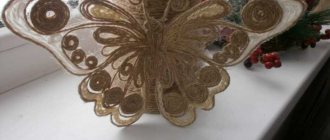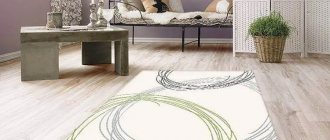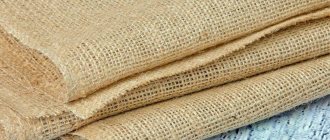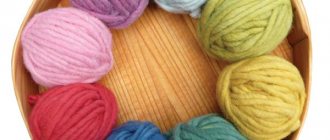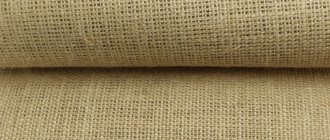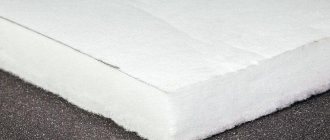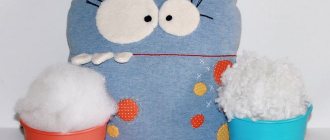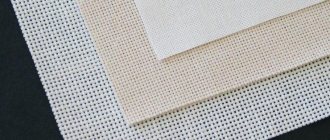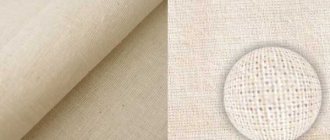14.12.2018
When choosing a carpet, buyers pay attention to both the appearance of the product and the materials used in the production process. Usually, with the compositions from which the pile is made, everything is more or less clear. These are wool, silk, cotton, viscose. But not everyone knows what the basis of a carpet is and what raw materials are used in its production.
Quite often you can find a base made of jute in carpets - what kind of material it is, what features it has and what you should pay attention to during operation will be discussed in the article.
What is a jute carpet backing?
Jute is a natural material of plant origin. It is distinguished by excellent performance characteristics and environmental friendliness.
Jute fiber is obtained from a plant of the same name. It grows in tropical countries, is extremely unpretentious, and is grown without the use of pesticides and chemical fertilizers. The plant is an annual plant, belongs to the linden family, and reaches a height of 3 meters per season.
The main advantages of the material are low cost and excellent strength. The jute base never deforms and will last for many years. The strength of the material is due to the content of a substance such as lignin in the plant. It is a high molecular weight polymer of plant origin that gives jute the characteristics of wood.
Separately, it is worth mentioning the interaction of jute with moisture. The jute base of the carpet is capable of absorbing water like a sponge, preventing it from harming the pile of the covering. In the future, the material will gradually dry out, maintaining its original shape. At 88% air humidity, jute fiber can contain up to 23% moisture and still remain dry to the touch.
Due to the widespread use of jute and the availability of raw materials, it is actively used not only in the production of floor coverings. In addition, transportation bags, ropes and cords are made from it.
Rope or jute rug
First step. Roll the rope, starting from the center, in a spiral and cut off the end with a sharp knife.
Second step. Fix the rope with silicone glue. Apply glue from the middle to the edges in 8 - 10 places.
Third step. Glue a thick base that will cover the glue.
The second option for handicraft made from these materials is a rectangular door mat for the hallway. Let's describe its creation step by step.
To make it, you will have to buy the cheapest rug in the store, or look around the house to see if there is an old one lying around in the pantry. The main thing is that it fits in size.
1. The thickness of the rope or rope depends on the preferences of the master. It is cut to the length of the base.
2. Next, the cut pieces are glued to the base very tightly to each other using silicone glue. Leave 5-10 cm from both edges unglued.
3. Unravel another piece of rope into fibers.
4. To prevent the ends of the rope from fraying, tie them with loose fibers from the rope. To create a decorative effect, fluff the ends of the rug a little.
Features of jute carpets
As a base, jute can be used for floor coverings made of silk, wool, as well as various synthetic materials - viscose, polypropylene, acrylic. At the same time, artificial carpets with a jute base are now found as often as woolen ones. Confirmation that jute was used for the base of the carpet is a special JU marking.
There are also products on the market made entirely of jute thread. They are valued for their naturalness, environmental friendliness and originality. Pleasant texture and natural colors allow you to harmoniously integrate the coating into almost any interior style. Some consider jute rugs to be too stiff, while others see this as an advantage.
In eastern countries such as Thailand and India, jute rugs are used as wall decorations. They sometimes look like works of art and may contain abstract drawings, landscapes and even portraits.
Advantages and disadvantages of jute carpets
Any material, even the most universal, has both advantages and disadvantages. If we talk about jute, then there will be much more of the former, and it doesn’t matter whether we are talking about the jute base of a woolen or synthetic carpet or a product made entirely of these natural fibers.
The advantages of a jute base are strength, durability and hygroscopicity, which helps protect the pile from excess moisture in the room.
The advantages of all-jute carpets include:
- Originality - such products are not often found in homes, they look stylish and attract attention;
- A large selection of models and shapes - you can choose a carpet for any interior after looking at the photos and options for use;
- Hypoallergenic;
- Resistance to mechanical stress;
- Possibility of use in rooms with high humidity levels;
- Relatively low cost, especially for industrially manufactured products (handmade is noticeably more expensive);
- Possibility of use for massage purposes - the rigidity of the coating will allow you to effectively massage your feet, and the mat can also be used during yoga practices;
- Versatility - can be used in the living room, bedroom, kitchen, hallway and even in the bathroom;
- Practicality - the carpet holds its shape well, does not slip on the floor, and does not wrinkle underfoot.
Jute has practically no disadvantages. The only thing we can call is the rigidity of the material. Therefore, it is rarely used as 100% of the carpet composition and is more often used to create a base in combination with pile of wool or other materials. This has a positive effect on the cost and characteristics of the product. Even an inexpensive synthetic carpet, the base of which is made of jute, will be much more attractive in terms of characteristics than a similar product made 100% of artificial materials.
- Quick view d058 – CREAM
from 713 show dimensions hide dimensions - Quick view d391 – BEIGE
from 1296 show dimensions hide dimensions - Quick view d066 – GREEN – Oval
from 1296 show dimensions hide dimensions - Quick view Sunrise 2 D549 – GRAY-BLUE
out of stock
↑ Foam-based carpet
Latex foam base is soft and durable, but has a service life of about 6 years
An alternative to rubber was latex, which began to be used as a soft and reliable base for carpet. This base is also called foamed. Foam-based carpet has excellent heat, noise and sound insulation characteristics. It provides a high level of comfortable walking and durability of the coating itself. To impart fire-resistant and dust-repellent properties, special additives are added to latex. But unlike the rubber base, latex has a short service life - about 6 years, after which it loses elasticity, cracks and crumbles. Rubber flooring is often used for garage floors.
Regardless of personal preferences and wishes, carpet should be selected according to the intended purpose of the room. Not only the type of carpet, but also the amount that will be spent on it will depend on this. The carpet itself is quite unpretentious in installation and does not require major repairs to the base. Of course, some preparatory work to level the surface will still have to be done, but it will be minor. Perhaps the only places where you should not use carpet are the bathroom, kitchen and toilet, due to constant high humidity. In all other rooms, carpet will cope with all tasks as a floor covering.
Caring for a jute carpet
There are no special features in caring for carpets with a jute backing. Although the material is natural, it is unpretentious, easy to clean, and is not afraid of moisture.
When caring for such carpets, you should follow the manufacturer’s recommendations and also the rules for caring for piles made of a particular material. It would be a good idea to vacuum the jute base itself once every few months. It is also worth making sure that the floor under the carpet remains clean and that dust, sand and other contaminants do not accumulate there.
If we are talking about a carpet made of 100% jute, but the main cleaning will also consist of regular use of a vacuum cleaner. Do not allow dust and other contaminants to accumulate on the carpet. This is unhygienic and contributes to the wear of the coating.
If a stain has formed on the surface, you need to get rid of it as quickly as possible before the fabric absorbs the dirt. To do this, use a soft sponge and detergent to care for jute carpets. You shouldn’t be afraid to get the carpet wet, but you shouldn’t over-wet the surface. You can either simply dry the area to be cleaned at room temperature, or you can try drying it with a hairdryer, but in a gentle mode.
If necessary, a small jute product can be washed, but reviews from those who have already tried this say that the carpet will become heavy after contact with water, it will be extremely difficult to handle it alone, and then it will take several days for the coating to dry .
To the begining
How to make jute rugs with your own hands
Today we’ll talk about how to make jute rugs with your own hands. We will talk not only about a specific option, but about various techniques for creating them. We will tell you how to work with twine correctly and how to fasten the parts together. In addition, you will learn how best to make a rug depending on the size and use case.
In this article you will also find some options for inspiration. You may want to make a jute rug according to the pattern you will find below, or come up with something of your own. The main thing is to master the principle of “assembling” the parts of this accessory and choose the appropriate option, and the rest is a matter of imagination.
How to choose jute?
There are several types of twine that can be used for various crafts. Using thin jute you can decorate glasses or vases, using medium jute you can knit lace napkins and coasters, and using the thickest jute you can create larger accessories.
To knit a jute rug, it is better to choose a thread with a thickness of at least 8 mm. It will be more difficult to work with thinner jute: stitching and gluing parts will become much more difficult. And the product itself will be more durable if you fasten it well with thick rather than thin twine. For one small rug you will need at least two skeins of standard size.
Option number 1: glue the rug
The easiest option is to glue a rug from jute rope using a glue gun. Using this technique you can make a really large rug. The main condition is a thick enough rope.
The process of creating parts is simple: we wind the thread in a circle and constantly fix it with glue. We make several parts and then fasten them together.
Pros:
- speed of production;
- ease of work;
- a large rug will be easy to make.
Minuses:
- very high glue consumption;
- fragility of the product.
If you want to make a jute rug with your own hands in this way, you may find this diagram useful.
With its help you can easily and quickly glue together a fairly large and very beautiful accessory. But keep in mind that you shouldn’t walk on it every day. It’s better to just lay such a rug in the living room (for example, under a coffee table) and leave it alone - then it will last a long time.
If your rug is unstuck, simply patch the piece up using a glue gun.
Option number 2: sew a rug
If you're willing to put in more effort, choose this option. It will be much more reliable to fasten the parts of the rug using thread rather than glue. To work, you will need a strong linen thread or thin jute.
The process of creating such a rug involves permanently fixing the jute with an additional thread. Just wind the jute in a circle and constantly stitch it with thread.
Pros:
- reliable fixation;
- the ability to create additional patterns when stitching;
- budget.
Minuses
- labor intensity of the process;
- It will be difficult for beginners to sew the parts of the rug evenly so that it does not bulge.
Typically this technique is used for sewing jute rugs that will be used every day. They will not fall apart or come apart at the seams, and will serve you for a long time. Using this technique you can make a carpet for the living room/bedroom or even a door mat.
Option No. 3: knitting and sewing
This option is for those who like voluminous carpets. Be prepared for the fact that this option is the most labor-intensive of all.
For work, you can choose jute with a thickness of 6 mm. First, you need to tie ropes from jute using a hook. This is a regular set of loops - there is no need to make patterns. When the ropes are prepared, start sewing them together in a circle. This can be done using jute of smaller thickness.
Pros:
- the product is voluminous;
- ease of stitching;
- structural strength;
- finished parts are sewn together quickly.
Minuses:
- very high consumption of jute;
- It will take a lot of time to create individual parts.
Using this technique, you can make jute rugs with your own hands for any purpose - they will turn out strong, beautiful and durable.
Choose any of the suggested techniques and create your own jute rug. If you wish, you can combine the presented options: the first with the second, the second with the third, the third with the first, or all three at once. Take a look at the examples presented in the article for inspiration and make your own unique accessory.
Views: 8,028
33-podelki.ru
